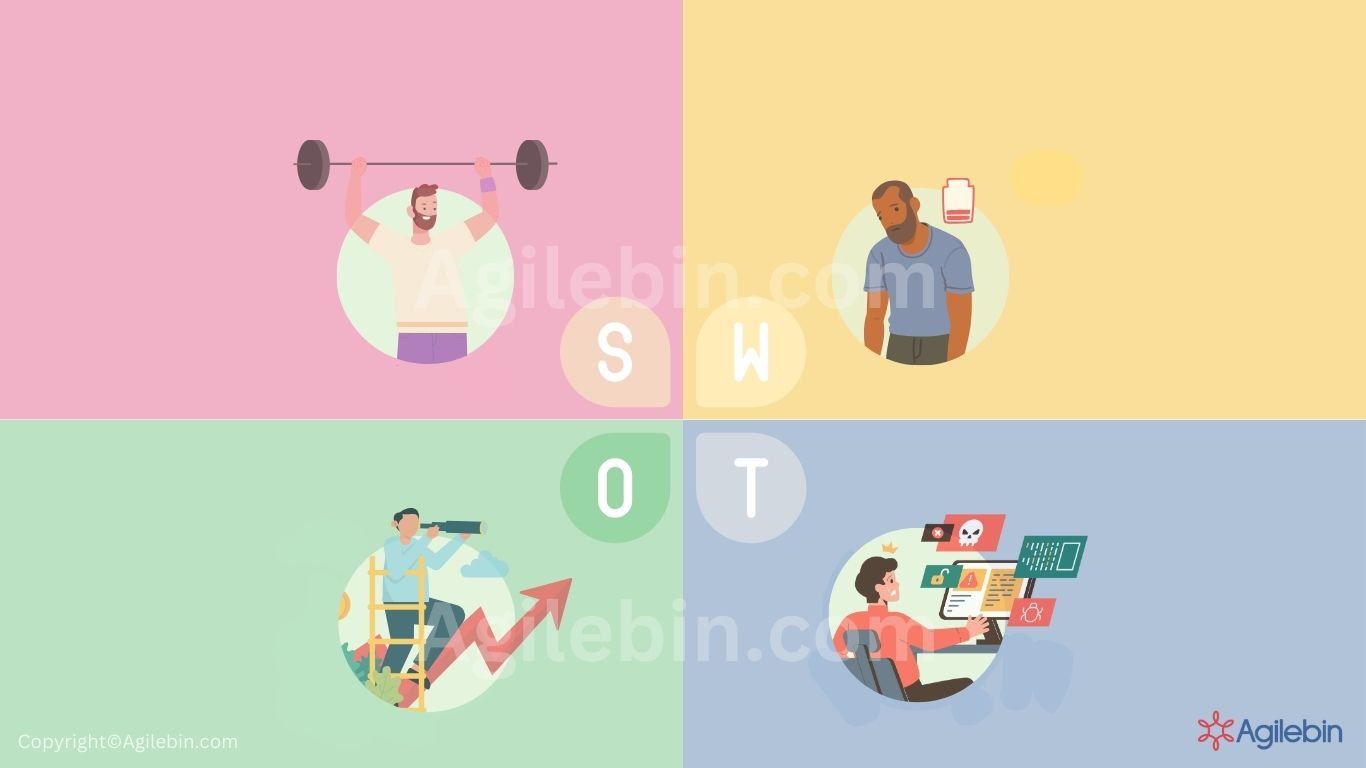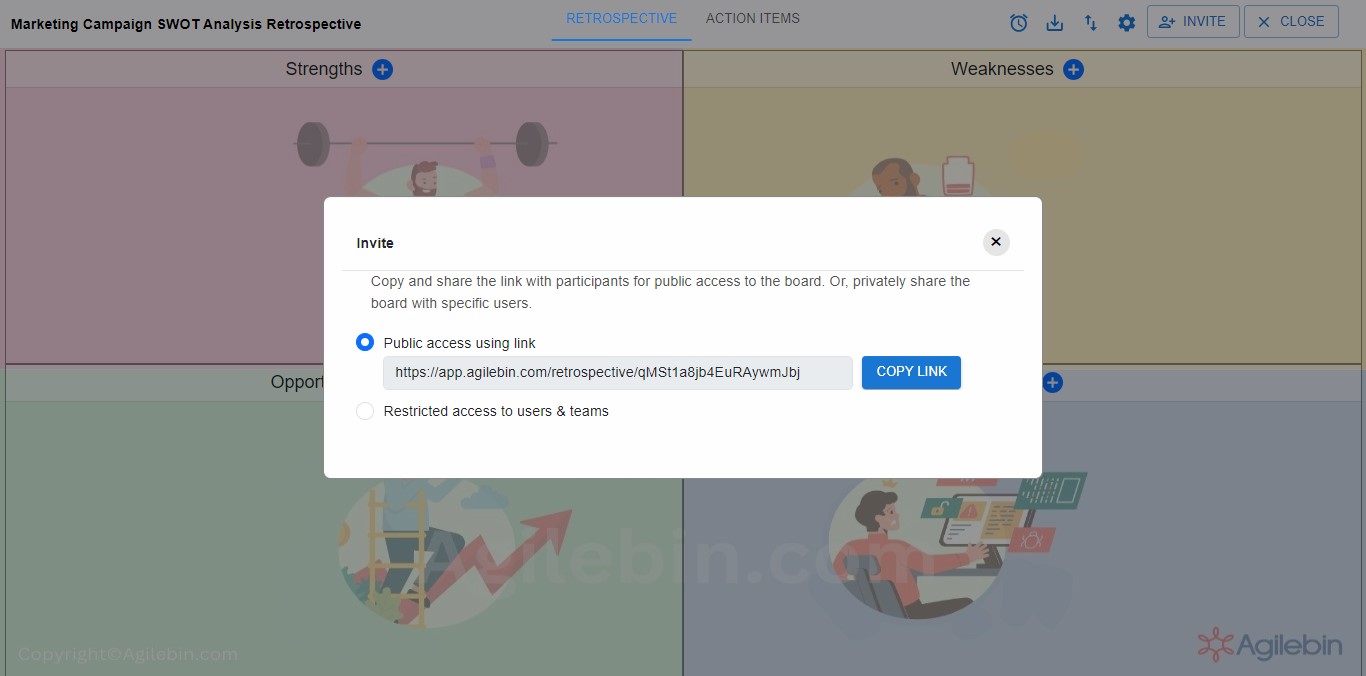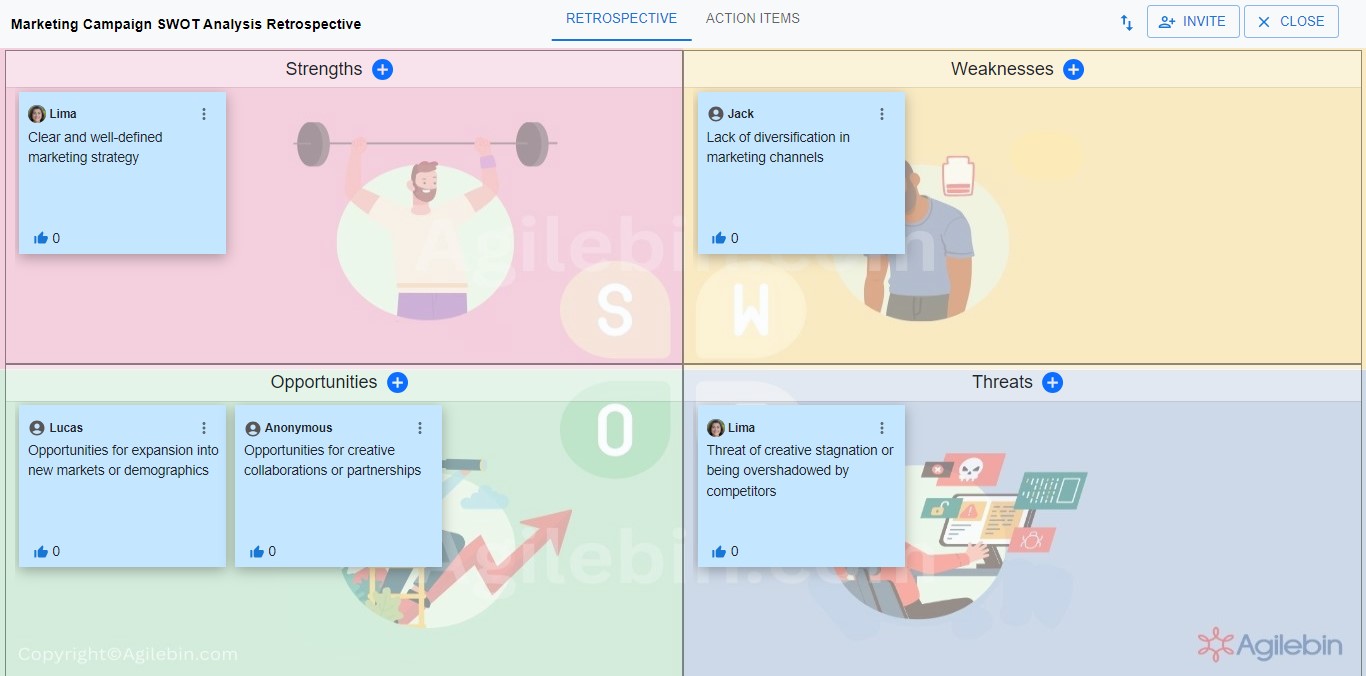SWOT Analysis Retrospective
Assessing strengths, weaknesses, opportunities, and threats to guide strategy

What is SWOT Analysis Retrospective?
The SWOT Analysis Retrospective is a method used by teams to assess their performance, identify strengths, weaknesses, opportunities, and threats (SWOT) related to a specific project, sprint, or period. Originating from strategic planning, SWOT analysis is adapted to retrospectives to provide a structured framework for evaluating past performance and planning future actions. In this retrospective, team members collaboratively identify internal strengths and weaknesses as well as external opportunities and threats, facilitating discussions on how to leverage strengths, mitigate weaknesses, capitalize on opportunities, and address threats for continuous improvement. SWOT analysis retrospectives encourage open communication, critical thinking, and strategic planning within the team, enabling them to make informed decisions and adapt their approach to achieve their objectives effectively.
How to Run SWOT Analysis Retrospective?
To run a SWOT Analysis Retrospective, follow these steps
- Diverse Perspectives: Encourage participation from team members with diverse backgrounds, roles, and perspectives to ensure a comprehensive and well-rounded analysis. Different viewpoints can provide valuable insights and identify blind spots that may not be apparent to everyone.
- Facilitated Discussion: As the facilitator, guide the discussion to ensure that all four aspects of the SWOT analysis (Strengths, Weaknesses, Opportunities, Threats) are thoroughly explored. Use probing questions to delve deeper into each aspect and encourage team members to share their thoughts and experiences openly.
- Visual Representation: Consider using visual aids such as a SWOT matrix or chart to visually represent the outcomes of the analysis. This can help to clarify complex concepts, identify patterns, and facilitate discussion around the key insights and findings.
- External Perspectives: Don't limit the analysis to internal factors only. Encourage the team to consider external factors such as market trends, customer feedback, industry benchmarks, and competitor analysis when identifying opportunities and threats. This broader perspective can provide valuable context and inform strategic decision-making.
- Action-Oriented Approach: Ensure that the SWOT analysis leads to actionable outcomes and concrete next steps. Collaboratively develop action plans with clear objectives, responsibilities, and timelines for implementation. Assign accountability for each action item to ensure follow-through and track progress over time.
- Continuous Improvement: View the SWOT analysis retrospective as a recurring process rather than a one-time event. Schedule regular follow-up sessions to revisit the SWOT analysis, assess progress on action items, and identify any changes in the internal or external environment that may necessitate adjustments to the strategy.
- Feedback Loop: Encourage feedback from team members on the effectiveness of the SWOT analysis retrospective process itself. Solicit suggestions for improvements and adjustments to enhance future retrospectives and ensure that the process evolves over time to meet the team's changing needs.
- Integration with Other Practices: Consider integrating the SWOT analysis retrospective with other agile practices such as sprint planning, backlog refinement, or strategic planning sessions. This ensures alignment between retrospective insights and broader team objectives, fostering a more cohesive and integrated approach to improvement.
Columns in SWOT Analysis Retrospective
Typically, the retrospective is divided into three columns:
- Strengths: During this phase, team members identify and discuss internal factors that contribute positively to the team's performance. This could include specific skills or expertise within the team, effective collaboration and communication processes, robust project management practices, or strong relationships with stakeholders. Strengths represent the team's advantages and areas of excellence that differentiate them from others.
- Weaknesses: In this phase, the team reflects on internal factors that hinder performance or present challenges. This could include skill gaps or knowledge deficiencies among team members, ineffective communication channels or processes, lack of resources or infrastructure, or bottlenecks in the workflow. Weaknesses represent areas where the team needs to improve or overcome obstacles to achieve its objectives.
- Opportunities: Participants explore external factors that could positively impact the team's performance or present new possibilities for growth and improvement. This could include emerging market trends or customer demands, technological advancements, potential partnerships or collaborations, or changes in regulatory or industry standards. Opportunities represent external factors that the team can leverage to their advantage to enhance their performance or achieve their goals.
- Threats: During this phase, the team identifies external factors that could pose risks or challenges to their success. This could include competition from other teams or organizations, market volatility or instability, changes in customer preferences or behavior, economic downturns, or legal or regulatory challenges. Threats represent external factors that could potentially disrupt the team's operations or impede their progress towards their objectives.
When to do a SWOT Analysis Retrospective
The SWOT Analysis retrospective is typically conducted at the end of a project iteration or sprint in agile or Scrum methodologies. It's an essential part of the iterative process, providing an opportunity for teams to reflect on their performance, identify areas for improvement, and celebrate successes.
Here are some common scenarios in which teams might choose to conduct a SWOT Analysis retrospective:
- End of a Project or Sprint: Conducting a SWOT Analysis Retrospective at the end of a project or sprint allows the team to reflect on their performance, identify key learnings, and assess the overall success of the endeavor. This retrospective provides valuable insights that can inform future projects and initiatives.
- Strategic Planning Sessions: SWOT Analysis Retrospectives can be integrated into strategic planning sessions to assess the team's current position and inform strategic decision-making. By conducting a SWOT analysis periodically, teams can stay agile and adapt their strategies to changing internal and external environments.
- Milestone Reviews: Teams may choose to conduct SWOT Analysis Retrospectives at significant milestones or checkpoints within a project to evaluate progress and identify areas for improvement. Milestone reviews provide an opportunity to course-correct and adjust strategies as needed to ensure successful project outcomes.
- Quarterly or Annual Reviews: Some teams opt to conduct SWOT Analysis Retrospectives on a regular basis, such as quarterly or annual reviews. These retrospectives provide a structured framework for evaluating performance over a longer period, identifying trends, and making strategic decisions to drive continuous improvement.
- After Significant Events or Changes: SWOT Analysis Retrospectives can also be valuable after significant events or changes within the team or organization, such as leadership transitions, restructuring, or market disruptions. These retrospectives help the team assess the impact of these changes and adapt their strategies accordingly.
How can you conduct a SWOT Analysis retrospective with Agilebin?
Effortlessly conduct a SWOT Analysis retrospective with Agilebin's ready-to-use template!
Why Agilebin's template? Because it provides a realistic and immersive experience, making your SWOT Analysis retrospective feel authentic and meaningful. With Agilebin's ready-to-use template, you'll feel like you're navigating through the actual process, allowing for a more effective and insightful retrospective session.
Choose SWOT Analysis retrospective template in Agilebin
Choose the SWOT Analysis Retrospective template from Agilebin's collection of retrospective templates. This template is specifically designed to facilitate the SWOT Analysis Retrospective process, providing a structured framework for your team's reflection and improvement discussions
Invite team members to participate in the retrospective session
Invite team members to participate in the retrospective session by adding their email addresses or sharing the session link directly with them. You can choose between public access using a link, allowing anyone with the link to join, or restricted access, limiting participation to specific users or teams.

Facilitate Discussion with Sticky Notes
Agilebin offers pre-defined columns for the SWOT Analysis Retrospective, including 'Strengths', 'Weaknesses', 'Opportunities', 'Threats'. Participants can add sticky notes to each column during the retrospective session, sharing their feedback, observations, and suggestions
